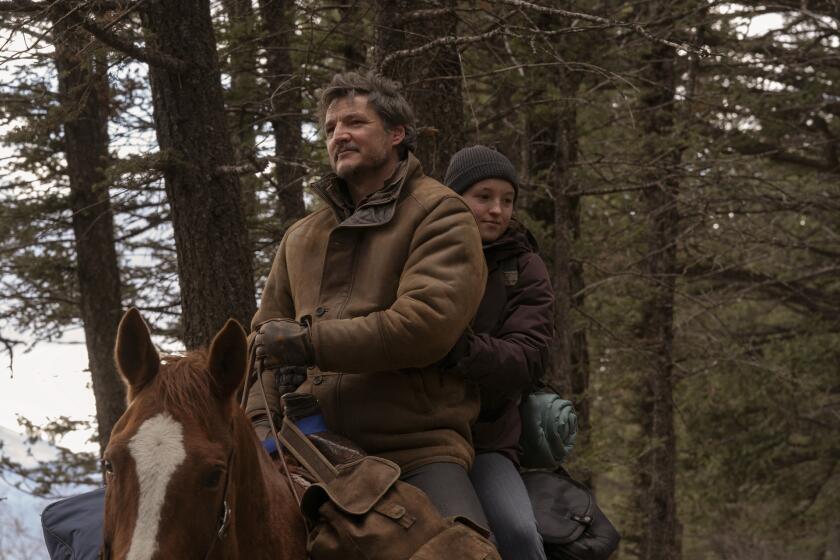Charlotte Salomon art exhibit opens at Contemporary Jewish Museum in San Francisco
- Share via
When Charlotte Salomon died in Auschwitz at age 26, she left behind an unperformed opera: “Life? Or Theatre?” It was in the form of 1,300 paintings — initially accompanied by overlays with words, and then, when she felt increasingly rushed, the words were written directly on the images. Sometimes they conveyed dialogue, sometimes a running narrative of a dramatic and tragic life — Charlotte’s life, the names changed ever so slightly. In 1940 she had shut herself up in a hotel in the south of France, a Jewish refugee from Nazi Germany, and had produced these works in a feverish pitch of 18 months.
Somehow she knew how little time she had left.
After the war, the paintings made their way to her father and stepmother, who in turn donated them to the Jewish Historical Museum in Amsterdam in 1971. Currently, 300 are in the show “Charlotte Salomon: Life? Or Theatre?” (through July 31) at the Contemporary Jewish Museum in San Francisco, mounted in sequence starting with a prologue, to her birth into a wealthy Jewish family in Berlin, through her joys and tribulations as personal and national history caught up with her.
A dozen years ago Connie Wolf, director of the San Francisco museum, saw the work in a book, then in person when exhibited on the East Coast. “It lives with you, it lingers with you,” she says. “I was so moved by the power of her art.... There are so many moving stories from this period, this one is about the power of art, how Charlotte struggled with her own fate.”
Others before her have felt the tug of the young woman’s story. Philosopher Paul Tillich has written: “the life of a very gifted and sensitive young woman, lived in one of the most terrible periods of European history ... speaks in the almost primitive simplicity of these pictures.”
Charlotte’s first tragedy was the loss of her mother when she was 9 — to pneumonia, or so she was told. Her father then married an opera singer, whom she adored. “Once her stepmother came into her life,” says museum curator Dara Solomon, “she’s surrounded by people in the arts.” In Charlotte’s opera, the main character reflects on her need to do something creative and takes up drawing and goes to art school. Meanwhile, the National Socialists and their anti-Semitic rant were claiming her world. One painting shows row upon row of brownshirts parading through the street under an angry red Nazi flag, another the chaos of Kristallnacht. In the narrative Charlotte writes, “The war raged on and I sat by the sea and saw deep into the heart of mankind.”
In 1939, Charlotte was sent to her grandparents in France. The year after, her grandmother committed suicide, and she finally learned that she came from a line of suicides — her mother had done so also. She and her grandfather were briefly interned, and the struggle for life and sanity became even more acute. After their release, she began her opus, “Life? Or Theatre?”
The earlier paintings are elaborate. She worked on the same-sized paper throughout, 10 inches by 13 inches, with short, nervous brushstrokes. She used only red, blue, yellow and white. “That alone is an incredible achievement,” Solomon says. In the latter work there are more close-ups and simple figures, as we get into the heads of characters, and as she begins to draw more hurriedly, almost frantic to get the story finished.
Charlotte married a fellow exile, and he made the mistake of getting them registered at a time when the French government collaborated with the Germans. They were arrested, taken away and murdered in the camp.
Charlotte’s opera, however, has a happy ending. At the end, despite the exhortation of her grandfather to go ahead and kill herself, she chooses life. She writes, “And she saw with eyes awakened from a dream all the beauty that surrounded her...” The last painting in the exhibition shows her sitting on the beach, facing the sea, a drawing pad on her lap. On her back she has written “Life or Theater.” For her it had been one and the same.
More to Read
The biggest entertainment stories
Get our big stories about Hollywood, film, television, music, arts, culture and more right in your inbox as soon as they publish.
You may occasionally receive promotional content from the Los Angeles Times.










